[Warning] This article contains spoilers for Frozen, Star Wars, and Joker. [Warning]
About ten years ago, a revolutionary Disney movie was released.
I first encountered Let It Go through the uncut music video on Disney's official channel on YouTube. Compared to the elegant, classic Disney soundtracks (mostly composed by Alan Menken) up until Tangled, Let It Go had a modern, "piercing" quality that made a profound impression on me. I remember thinking at the time, "Disney may have created something monumental here."
Eventually, Frozen became a global phenomenon, breaking numerous records and becoming a legendary hit; its theme song, "Let It Go," alone broke records and even dominated the Far East, Japanese variety shows for almost a month.
However, the movie Frozen itself has received some criticism. For example, CinemaSins released a video titled "Everything Wrong With Frozen," highlighting the "oddities" in the story. Among viewers, opinions like "The songs are amazing, but I didn't like the story" were fairly common. This sentiment wasn't limited to English-speaking audiences; it was echoed in other cultural spheres as well.
However, Toshio Okada has praised Frozen as a masterpiece that influenced not only subsequent Disney movies but even other superhero films.
Okada is one of the founding members of the legendary Japanese animation studio GAINAX, known for the Evangelion series, and has long been involved in anime production, leaving a significant mark on the Japanese animation industry. On his channel, he noted that critics of Frozen often lack the perspective of an anime creator.
Okada also pointed out that the Japanese translation of Let It Go has led to many misunderstandings among Japanese audiences. However, he clarified that this is not due to poor translation quality but rather the substantial limitations imposed by the linguistic differences between English and Japanese in translating song lyrics.
In this article, I would like to translate and share with you some of the key points Okada discussed on his channel, focusing especially on Elsa's desperation and the inherent "difficulty" of translation.
[Reference] UG# 266: Examining Why Frozen Was Such a Hit on Friday Roadshow – January 27, 2019
(【UG# 266】金ロー『アナと雪の女王』ヒットの理由を考える 2019/1/27)
[Okada]
What's remarkable about Let It Go, which became a social phenomenon at the time of its release, is that it shows Elsa, the desperate protagonist, transforming into a villain akin to Darth Vader in the Star Wars series. The revolutionary aspect of this scene is that it presents Elsa's tragic and terrifying descent into monstrosity in a way that appears to be a positive transformation - Elsa liberates herself and embraces her humanity.
Since this work, the portrayal of villains in film has changed significantly. In Tim Burton's Joker, the character's revelation as a demonic being is presented as a very frightening event, but in Elsa's case, her villainous transformation is presented as an almost miraculous event, increasing the chilling effect of the scene. This complex expression is embodied in Let It Go.
In this video, I want to focus on and explain this particular aspect of the scene.
Let me add some background here:
Elsa, the princess of Arendelle, was born with magical powers to create snow and ice. When she was eight years old, she accidentally injured her younger sister, Anna, leaving her unconscious. Thanks to the efforts of the Trolls, Anna’s life was saved, but from that point on, Elsa shut herself away in isolation and ceased going outside except for official royal duties.
Ten years later, Elsa and Anna’s parents perished in a maritime accident, leaving Anna as Elsa’s only remaining family.
The pivotal incident occurs three years later on the night of Elsa’s coronation. Anna tells Elsa she wants to marry Hans, a prince from a neighboring kingdom whom she just met at the coronation events. Naturally, Elsa opposes the idea, leading to an argument with Anna. In the heat of the moment, Elsa accidentally reveals her dangerous magical powers in front of everyone.
At this point, Elsa experiences two profound setbacks:
- Elsa had distanced herself from Anna after the childhood accident, fearing her powers might harm her again. Despite this, she continued to love her sister deeply as her only family. However, when Anna declares her intention to marry someone she just met, Elsa is devastated. Whether Elsa could see through Hans’s true nature or not remains unclear, but she was deeply disheartened by Anna’s lack of discernment in trusting people.
- Elsa had been striving to endure the pressures of being a queen while trying to behave as a “normal, upright person.” Yet, at her coronation, her dangerous powers were exposed, and she was publicly branded a “monster” by the guests. This moment reaffirmed to Elsa that she was not an ordinary person, plunging her further into despair.
Having lost both her sense of family and her identity as a normal human being, Elsa retreats to the snowy mountains, carrying profound despair, leading to the iconic Let It Go scene.
[Okada]
The reason this movie is so highly praised is because of the song "Let It Go," but many Japanese audiences are familiar with the translated version. Unfortunately, the Japanese lyrics significantly alter the original intent, making it more of a "parody" than a "translation".
In the Japanese version, Elsa seems to sing only positive things, but the English version conveys a much more complex message. Elsa's desperation is subtly revealed in the nuances of the English lyrics, but due to linguistic limitations, it was impossible to fully incorporate this complexity into the Japanese translation.
Take the most important part, "Let it go, let it go. There's already a shift in nuance. In Japanese, it's rendered as "ari no mama no (Let it be)," but in the English version, Elsa's words convey a much more resigned attitude, something closer to "Enough is enough! I don't care anymore!” This reflects Elsa's sense of throwing everything away in frustration.
Let's take a closer look at the lyrics from the very beginning.
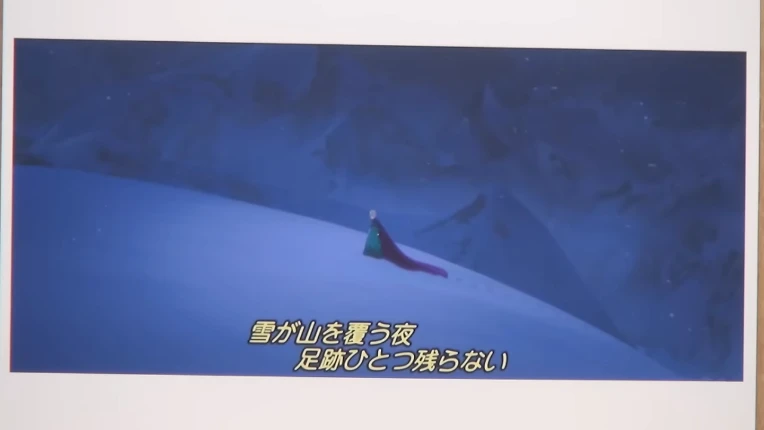
The snow glows white on the mountain tonight
Not a footprint to be seen
Elsa climbs the snowy mountain as the camera closes in on her.
This part serves as a metaphor for Elsa shedding all traces of her life in human society. She had worked tirelessly to become a "good queen," but this scene symbolizes how all her efforts have come to nothing. In addition, Elsa is dragging a heavy cloak behind her in this scene. Originally meant to protect her from the cold, the cloak now symbolizes a burdensome shackle. In other words, this cloak represents the overwhelming pressure Elsa felt living as a queen in human society.
Just from this visual composition, I can tell that this movie is a masterpiece. Critics of this movie often lack this kind of perspective. Unlike live-action films, where unforeseen events can occur, everything shown in animation is intentional and serves a specific expressive purpose. It is important for us as viewers to carefully interpret and appreciate these intentional expressions.
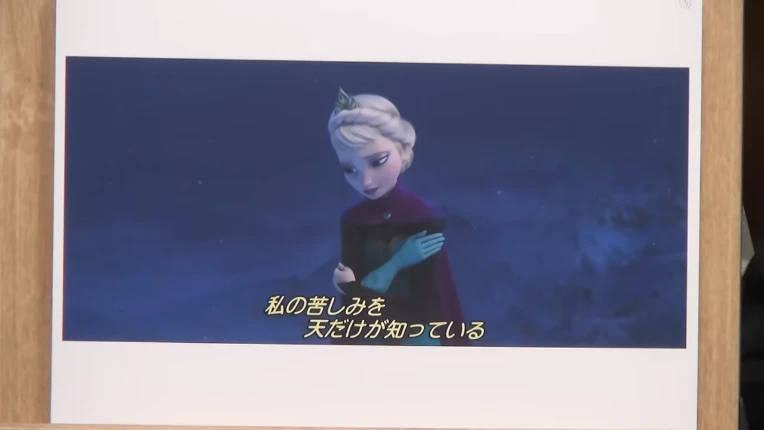
A kingdom of isolation
And it looks like I’m the queen
In this scene, Elsa begins to take off her coat. This means that she is gradually losing her sense of feeling the cold. Elsa, still human at the beginning, undoubtedly felt the chill of the snowy mountain. From that moment on, however, we glimpse her transformation into a creature no longer bound by human traits - a monster immune to the cold.
If this were Darth Vader from Star Wars, his descent into darkness would be revealed by his black transformation, symbolizing his corruption by evil. In contrast, this film conveys Elsa's "villainous transformation" by showing her becoming whiter and more beautiful, achieving the same thematic effect through an inverted visual approach.
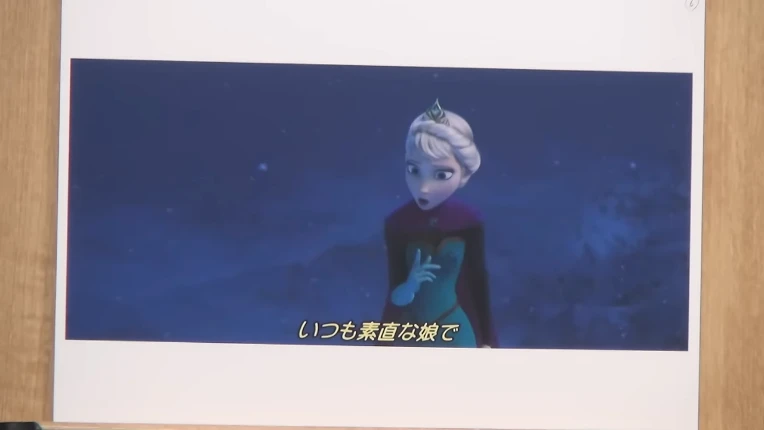
Don’t let them in, don’t let them see
Be the good girl you always have to be
This part can be a bit unclear due to differences in the Japanese translation, but it can be interpreted that Elsa is imitating her parents. In this scene, Elsa remembers the things she was told over and over again throughout her childhood.
Well, now they know
In this scene, Elsa takes off her gloves. These gloves had served as a device to suppress her magic, but here she breaks the seal on her powers and begins to test the full extent of her magical abilities.
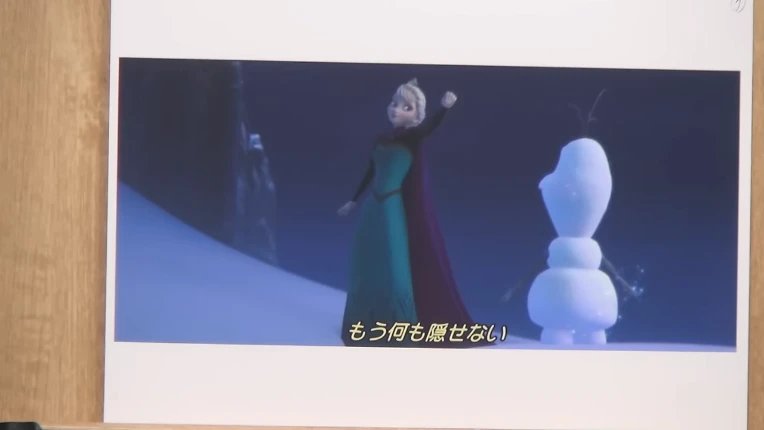
Let it go, let it go
Can’t hold it back anymore
In the Japanese translation, this part is similar to "Let it be," but the original phrase is actually one used to encourage someone who is upset-such as a friend who has been rejected or lost a job-to say, "Don't dwell on what's already over. Just forget about it!"
Elsa utters these remarkably "negative" words with a beaming smile. This must have left English-speaking viewers with a chilling sense of unease.
Immediately thereafter, Elsa breathes life into a snowman. Although this snowman later becomes the adorable character Olaf, it's worth noting that in Christian cultural contexts, the act of breathing life into inanimate objects is associated with witches or demons. In this sense, this scene represents Elsa's further descent into the dark side.
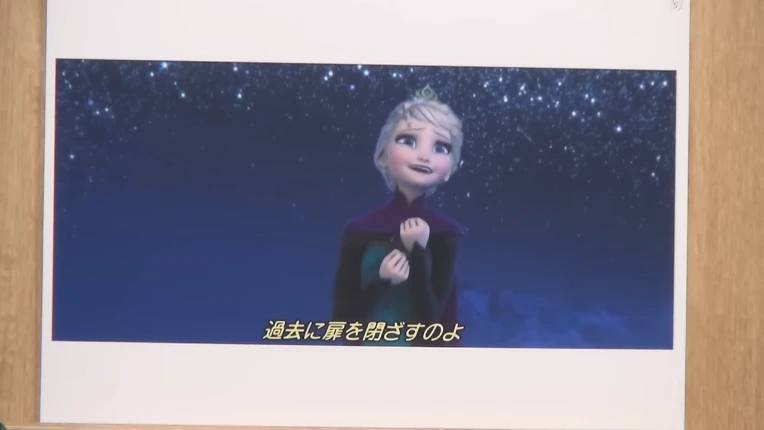
Let it go, let it go
Turn away and slam the door
For English-speaking audiences, the act of "slamming the door" conveys a very negative and strong message, symbolizing a complete rejection of someone and a total severing of the relationship. However, Elsa's expression when she sings this phrase is still full of a smile.
To make this scene more relatable to Japanese viewers, we can compare it to an anime. The atmosphere is similar to a scene in the anime Kakegurui where a character points a gun at someone and yells, "If everyone d*es, everything will be solved! Everybody just d*e! HAHAHA!!" In Japanese anime, such scenes often include another character trembling in fear of her insanity. This setup clearly conveys her deranged state of mind. In Frozen, however, there is no character to fill this role, making it harder for the audience to recognize Elsa's descent into madness.
In a way, this scene is reminiscent of the famous dance scene in the recent Joker movie after he kills the businessmen. In that scene, the Joker, intoxicated by the pleasure of violence, comes to terms with and reveals his true nature. Similarly, in this scene from Frozen, Elsa - who once aspired to be a self-controlled, "good person" - denies her past self. Depending on your perspective, this can be interpreted as a deeply sad moment. Some viewers, especially women, recognized and resonated with it as a representation of "her demonic nature unleashed." However, the beautiful visuals and music make it difficult for this sad nuance to come across.
Unbeknownst to Elsa at the time, the release of her powers will lead to a great catastrophe in the kingdom. Through this storyline, the film subtly conveys a disturbing message that seems far from child-friendly: "To be truly free, you must not be afraid to be antisocial. This message is cleverly hidden within the narrative. In this sense, Frozen is actually much more provocative in its themes than Japanese anime.
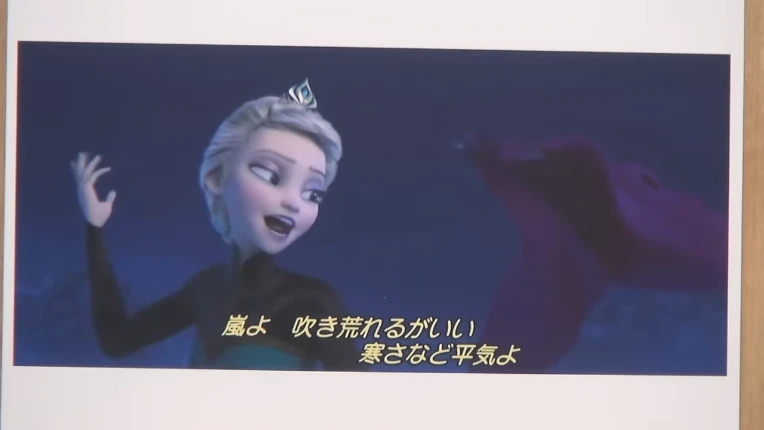
I don’t care what the’re going to say
Let the storm rage on
The cold never bothered me anyway
By this point, Elsa has already turned into a monster and lost the ability to consider how her powers cause suffering for the people of the kingdom. While Disney films rarely depict death in an overt way, the reality is that very few Disney films are entirely devoid of death. Snow-covered Arendelle was experiencing one of its rare summers, but Elsa's sudden transformation plunged it back into freezing cold. Naturally, this change in climate would have resulted in some deaths, but the movie completely omits such consequences.
Also, a skilled translator would probably notice the incongruity in the last word of her song - "anyway" instead of "anymore". At the beginning of the song, Elsa was indeed shivering with cold. However, she declares, "The cold never bothered me anyway," suggesting that she never felt cold to begin with. In this scene, having abandoned her place in human society, Elsa has completely lost her humanity and is beginning to forget even her memories of being human.
Earlier in the story, Elsa was portrayed as a woman with a strong sense of justice, striving to be a good queen for the people of Arendelle. But in this moment, she becomes a monster, indifferent to the potential deaths of her subjects, trading her humanity for overwhelming magical power.
This concludes the content of this article. Thank you for reading to the end.
At one point, I aspired to become a professional translator, but even so, I didn’t realize that “anyway” wasn’t “anymore.” In fact, when I sang this song at karaoke, I sometimes got the lyrics wrong and thought, “Oh, I messed that up,” but that was about the extent of my reflection.
Even before hearing Okada's insights, I was aware that there had been some criticism of the Japanese translators for interpreting "Let It Go" as something like "Let It Be" or "Show me as I am," and I personally felt that "Let It Go" probably meant something like "Leave it as it is," but I wasn't able to articulate that sense as well as Okada.
When asked if the translators were unaware of this nuance, I believe that this is not the case for many reasons. Personally, I feel that, aside from this aspect, the translation of Let It Go was handled with professional accuracy, even under the severe constraints of translating from English to Japanese. Clearly, the anonymous translators must have understood the layered meanings hidden in Let It Go. Knowing this, they deliberately adapted the lyrics with a positive interpretation appropriate for a children's film, resulting in the nearly original Japanese version we know as "Ari no Mama de (As I Am)."
And that, it seems to me, now implies the struggle of the translator, who is forced to work dishonestly with the meaning of the source text, the more familiar the translator is with the language. The difficulty of conveying not only linguistic differences, but also the nuances created by cultural and value differences, with minimal explanation to a general audience is now glaringly obvious to me. This realization has shocked me as a "translationfag" to my core, and it feels like there's no immediate solution to this problem. This is a very negative conclusion, but I believe that if I listen to "Let It Go" and consult many interpretations like Okada's, I could grasp a lot of its true meaning, so I feel optimistic in that sense.